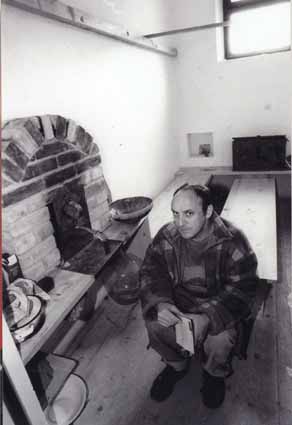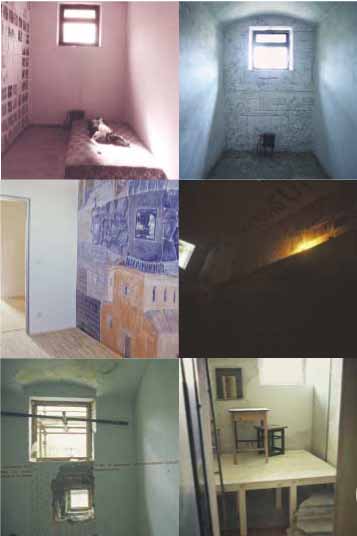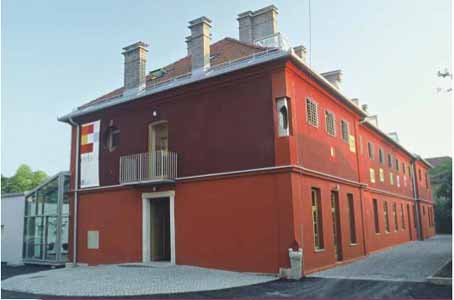
1989-1993, Network for Metelkova (group of more than 200 artists and different independent workers in the field of culture)
During this period different artists and other people who worked in cultural field established the Net for Metelkova. Its aim was to persuade the Yugoslav army to leave the city center and to hand over the military barracs at Metelkova street for the cultural and artistic activities. After the war for Slovenian independence in 1991, Yugoslav army actually abandoned the barracs and city government has promised to the Network for Metelkova that the barracs will be put in use for cultural purpose. But instead of fulfil their promise, city government tried to damage most of the buildings. They wanted to build brand new neighbourhood- that's why damaged buildings were the best possibility to convince the public for changing the plan. But people, united under the Network for Metelkova, squatted the area and begun with their aristic activites in 1993.

1993- 2003
Group of Sestava (Sestava means Composition) was active mostly in the former military prison. The building was more than 100 years old and was built for the military prisoners during the Austro-Hungarian period (1881-86). This building was twice enclosed: one wall was built around the entire millitary camp and the other was built around the prison extra.
Group of Sestava wanted to open the building literally and metaphorically: to re-form and renovate the prisons into the youth hostel throught the art process.

The Group of Sestava was established by artists, architects, art historians, scientists but in the process of renovation of the prisons, Group of Sestava invited many other creative people (from different countries and different proffesions). First steps in renovation were both settling the places for creative work and thinking and discussing about the concepts of this long term art process.
In the basement of the building solitary cells were found, where people were imprisoned at only 150X250cm small place (high aprox. 320cm) in complete darkness.
 The
first art work which was concieved in discussion among the artists and other
members of the group was "fresco" painting, painted in the corridor
just in front of the dark-rooms. It was very important for the group because
we made a decision to reconsider the ethical potentials and ethical meaning
of art.
The
first art work which was concieved in discussion among the artists and other
members of the group was "fresco" painting, painted in the corridor
just in front of the dark-rooms. It was very important for the group because
we made a decision to reconsider the ethical potentials and ethical meaning
of art.
We also invited different artists to make an installation in different cells in the first flour of the prison. But each invited artist was lead through the solitary cells- dark rooms at the basement and was asked to start the artwork from the ethical point of view. Invitation for artists were made as vessels and were hand over personally.
 Over
80 artists exhibited in cells of former prison and many of them helped us to
furnished cells for the youth hostel 2003. In this period we also established
the place called Srečišče (it is a new word in Slovenian language and it has
more meanings- meeting place, center, intersection...) In this place (photo
below) we used to organize workshops, lectures, concerts and exhibitions.
Over
80 artists exhibited in cells of former prison and many of them helped us to
furnished cells for the youth hostel 2003. In this period we also established
the place called Srečišče (it is a new word in Slovenian language and it has
more meanings- meeting place, center, intersection...) In this place (photo
below) we used to organize workshops, lectures, concerts and exhibitions.

It is very important for reader to know that all the time from the 1993 to the 1997 (and even further) city government tried to achieve their plan of destruction of the entire military barracs and to build the new neighbourhood. So people, who were engaged at the entire military area, worked there without water and electricity.
First support from the cultural department of the city government came in 1997, when we attend the competition for the EU month of culture. With the limited fund we managed to renovate the gallery Srečišče and to furnished two cells. These two cells served also as some kind of example for visitors to see how the cells of new youth hostel could be furnished. Each visitor of youth hostel would live and sleep in the art work...


Painter Žiga Okorn made first cell as an example of the future "look".


I furnished the cell soon after Žiga.
Few other cells at the end of 90's:

Apearance of the Celica hostel and selected cells at the end of the process of renovation:


The core group of Sestava:
Architects: Janko Rožič, Ira Zorko, Aleksander S. Ostan
Art historian: Vesna Krmelj
Painter: Žiga Okorn
Sculptor: Jiri Kočica
Additional links:
Guardian about the Celica hostel Ljubljana
Lonely planet about the Celica hostel Ljubljana